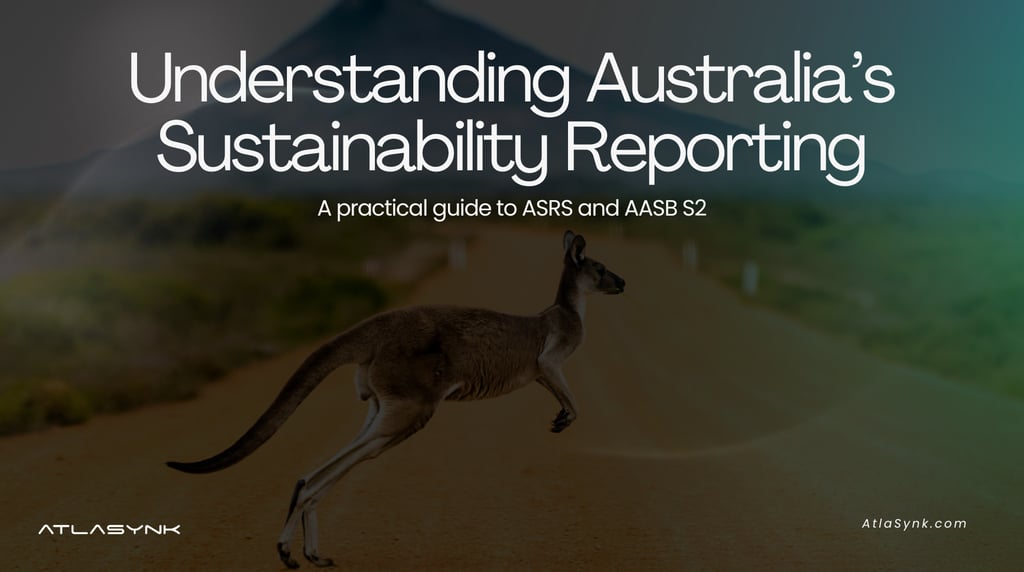Understanding Australia’s Sustainability Reporting
Understanding Australia’s Sustainability Reporting: A practical guide to ASRS and AASB S2
Marcelo F. Dias, Diogenes Eli Casas Samper
10/21/202511 min read


Understanding Australia’s Sustainability Reporting: A practical guide to ASRS and AASB S2
Version 1.1 • As at 20 October 2025 (AEST)
How to use this guide
This guide is explanatory rather than prescriptive. It explains who the rules apply to, what types of information may be expected in a sustainability report, and practical concepts such as scenario analysis and value chain data. It also lists official sources so readers can confirm details and discuss next steps with their advisers (AASB, 2025; ASIC, 2025).
Executive summary
From financial years beginning 1 January 2025, many larger Australian entities must publish an annual sustainability report that contains climate-related financial disclosures, alongside the financial report and other annual reports (ASIC media guidance; Corporations Act s 292A). The duty applies if an entity already prepares a financial report under Chapter 2M and it meets one of the s 292A in-scope tests, including a size test that uses the long-standing thresholds for large proprietary companies: $50 million revenue, $25 million assets, and 100 employees (meet any two), or other pathways such as being an NGER reporter or certain asset owners (ASIC; Corporations Act s 292A; Corporations Regulations reg 1.0.02B).
What goes in the sustainability report is set out in AASB S2 Climate-related Disclosures, the Australian standard based on IFRS S2. Disclosures cover governance, strategy (including scenario analysis), risk management, and metrics and targets (including Scope 1 and 2, and Scope 3 where material). The AASB confirms the regime is designed to be interoperable and that the obligation is only for entities that already report under Chapter 2M and meet the s 292A tests (AASB S2; AASB’s Overview of ASRS).
Non-compliance with s 292A is treated like other breaches of statutory reporting. Directors must take reasonable steps to ensure reporting compliance, and entities can face civil penalties and regulatory action for omissions or misstatements (Corporations Act; ASIC). Practically, businesses should confirm whether and when they are in scope, map current capabilities to AASB S2, plan for scenario analysis and value-chain data, and organise sustainability records for assurance. The phase-in starts with the largest entities for years beginning on or after 1 January 2025, with further cohorts following (ASIC; AASB; ASIC media release).
Background and context
The Australian Government has introduced a phased legislative regime for climate-related financial disclosures in order to give investors and stakeholders “clearer and more consistent information about climate risks and opportunities.” This regime represents a shift from voluntary sustainability reporting to a mandatory framework that is embedded in the Corporations Act 2001 (Cth). Lawmakers moved to legislate because climate-related risks are financial risks that can affect company valuation, access to capital and long-term resilience. The Treasury’s policy statement explains that the reform aims to “enhance the quality, consistency and comparability of climate-related financial disclosures across the Australian economy.”
Parliamentary and policy materials highlight several reasons for the change:
1. Inconsistent voluntary reporting. Prior to reform, disclosures were voluntary and often varied in coverage, quality and comparability, which reduced market confidence and transparency.
2. Investor protection and market efficiency. Legislators noted that comparable climate disclosures are necessary for investors to make informed decisions about a company’s exposure to climate-related risks and opportunities.
3. Alignment with global standards. Australia designed its framework to align with the International Sustainability Standards Board’s standards so disclosures are interoperable and so Australia remains attractive to international capital.
4. Embedding accountability. By using the Corporations Act and related instruments, sustainability reporting carries the same legal standing and enforcement mechanisms as financial reporting.
5. Systemic financial stability. Treasury stated that better disclosures would help regulators monitor and address systemic risks to the financial system that arise from climate change and from transition efforts.
As a result, the Corporations Act now requires certain entities to prepare a sustainability report as part of the annual reporting package. The Australian Accounting Standards Board has issued AASB S2 to specify the climate disclosure content. AASB S2 is based on IFRS S2 and is intended to be interoperable for global users of financial statements (Corporations Act 2001 s 292A; AASB S2, 2024; AASB, 2025; ASIC, 2025).
Who must report and when
Australia’s sustainability reporting regime does not apply to every business at once. The obligations phase in over time. The first question is how the law defines “size.”
Under the Corporations Regulations 2001 (Cth), a company is “large” if it satisfies at least two of three thresholds: revenue of AUD 50 million or more, gross assets of AUD 25 million or more, and 100 or more employees at year end (reg 1.0.02B). If an entity meets any two of these thresholds and it is already required to prepare an annual financial report under Chapter 2M of the Corporations Act, then s 292A applies and the entity must also prepare a sustainability report (Corporations Act 2001 ss 292, 292A; Corporations Regulations 2001 reg 1.0.02B).
Size is not the only pathway. The law also captures entities that are registered and reporting under the National Greenhouse and Energy Reporting Act 2007 and certain asset owners, including registered schemes, registrable superannuation entities and retail corporate collective investment vehicles, where the relevant thresholds are met (ASIC, 2025). The transition is staged. The earliest cohort, which is the largest group of entities, starts for financial years beginning on or after 1 January 2025. Additional cohorts commence in later years. Entities should confirm their start dates by consulting ASIC’s guidance, AASB material and the relevant Acts and Regulations that apply to their sector (ASIC, 2025; AASB, 2025).
What information is expected in the sustainability report
The sustainability report usually includes climate statements for the year, notes to those statements and a directors’ declaration. The sustainability report sits alongside the financial report, the directors’ report and the auditor’s report in the annual reporting package (ASIC, 2025). AASB S2 sets disclosure requirements across governance, strategy, risk management and metrics and targets. Entities disclose Scope 1 and Scope 2 greenhouse gas emissions, and Scope 3 emissions where these are material. Many entities explain how climate risks may influence the business model and cash flows over different time horizons. Scenario analysis is used to describe resilience and potential responses (AASB S2, 2024; AASB, 2025).
Consequences of non-compliance
If an entity that is in scope fails to prepare or lodge a sustainability report as required by s 292A, this is a breach of statutory reporting obligations. Sustainability disclosures carry the same legal status as financial reporting, and directors and officers must take reasonable steps to ensure compliance (s 344(1)). Where required climate statements, notes or the directors’ declaration are omitted or misstated, potential outcomes include civil penalties under Part 9.4B, action by ASIC that may involve infringement notices, enforceable undertakings or court proceedings, and director liability in appropriate cases. In more severe cases, non-compliance can lead to public enforcement proceedings, reputational damage and possible disqualification of directors under s 206C if failures indicate systemic governance problems. Sustainability reporting is a statutory requirement within the annual reporting suite, and the consequences are similar to failing to file audited financial statements (Corporations Act 2001; ASIC, 2025).
What information is expected in the sustainability report
The sustainability report typically includes climate statements for the year, any notes to those statements, and a directors’ declaration. It sits alongside the financial report, the directors’ report, and the auditor’s report in the annual reporting package (ASIC, 2025).
AASB S2 sets disclosure requirements across governance, strategy, risk management, and metrics and targets. The standard expects disclosure of relevant greenhouse gas emissions, often described as Scope 1 and Scope 2 emissions, and Scope 3 emissions where these are material. Many entities will explain how climate risks could influence their business model and cash flows over different time horizons. Scenario analysis is used to illustrate resilience and possible strategic responses (AASB S2, 2024; AASB, 2025).
Explaining the four disclosure areas in plain language
Governance
Governance disclosures explain who is responsible for oversight of climate related matters and how they exercise that role. Boards may describe the committee structure, the skills and training relevant to climate issues, the information they receive, and how climate responsibilities are allocated to management. The emphasis is on giving users a clear understanding of oversight rather than prescribing any particular governance model (AASB S2, 2024; ASIC, 2025).
Strategy
Strategy disclosures focus on how climate related risks and opportunities could influence the business model and financial position in the short, medium, and long term. Entities often discuss transition risks such as policy or market shifts and physical risks such as severe weather, as well as opportunities such as new products or services. Scenario analysis helps readers understand resilience under different conditions. The level of detail can grow over time as data and methods improve (AASB S2, 2024; AASB, 2025).
Risk management
Risk management disclosures describe processes for identifying, assessing, monitoring, and managing climate risks and opportunities. Many entities link these processes to their existing enterprise risk management approach so that climate risks are not treated as a separate or parallel system. The aim is to show integration and clarity about who does what and how information flows to decision makers (AASB S2, 2024).
Metrics and targets
Metrics and targets disclosures provide the quantitative information that supports the narrative sections. Entities commonly disclose Scope 1 and Scope 2 emissions and consider Scope 3 where material. Targets should be specific and measurable, with the calculation methods explained at a level that allows an informed reader to follow the approach. Readers should be able to understand baselines, units, and any changes from the prior year (AASB S2, 2024; AASB, 2025).




Practical concepts in simple terms
Scenario analysis
Scenario analysis is a structured way to explore how different climate pathways could affect the entity. A simple starting point is to consider a pathway that aligns with lower levels of warming and a pathway with higher levels of warming. Entities can begin with qualitative descriptions of implications and improve the quantification over time as data and tools develop. The report should explain methods and key assumptions in clear terms so that readers can understand the basis for conclusions (AASB S2, 2024).
Value chain information
Value chain information refers to relevant upstream and downstream activities that can affect climate related risks or metrics. Many entities begin by mapping material categories and by asking key suppliers for a small set of data. The extent of value chain information can increase in later years as systems and relationships mature. This staged approach is consistent with an emphasis on clarity and continual improvement rather than perfection on day one (AASB S2, 2024; AASB, 2025).
Sustainability records and assurance readiness
The Corporations Act requires entities to keep sustainability records that explain the information in the sustainability report. These records help management support the disclosures and allow an assurance provider to trace numbers and claims to source evidence. Keeping organised workpapers and documenting assumptions can reduce the effort of future reporting cycles and assurance work (Corporations Act 2001 s 292A; ASIC, 2025).
Small and medium businesses and supply chains
Small private businesses are generally not required to prepare a sustainability report under section 292A because they are outside Chapter 2M financial reporting or do not meet size thresholds. However, some smaller suppliers may receive requests for information from larger customers who are preparing their own reports. This is a commercial consideration rather than a legal requirement. A simple data sheet that explains energy use and key policies can be a practical first step for suppliers (ASIC, 2025).
Frequently asked questions
Do we have to comply if we are small?
Small proprietary companies are usually outside the scope of section 292A. The requirements target larger entities that already have to prepare financial reports under Chapter 2M or that fall into specific categories such as NGER reporters or asset owners (Corporations Act 2001 s 292A; ASIC, 2025).
Where can we find the numeric thresholds?
The thresholds for large proprietary company status are set in Corporations Regulations 2001 regulation 1.0.02B. They are 50 million dollars revenue, 25 million dollars assets, and 100 employees measured on a consolidated basis. Meeting any two satisfies the test for that concept. For sustainability reporting, section 292A applies where the entity also has a Chapter 2M financial reporting obligation (Corporations Regulations 2001 reg 1.0.02B; Corporations Act 2001 s 45A; Corporations Act 2001 s 292A).
When do disclosures start?
The first cohort begins with financial years starting on or after 1 January 2025. Later cohorts follow in subsequent years. Readers should confirm timing with ASIC materials and their advisers (ASIC, 2025; AASB, 2025).
What if our parent company reports overseas?
An overseas parent’s sustainability report does not automatically remove obligations for an Australian entity if the Australian entity meets its own scope tests. Local advice is recommended to confirm any reliefs or consolidation approaches (ASIC, 2025).
What is the difference between AASB S1 and AASB S2?
AASB S2 specifies climate related disclosures. AASB S1 provides general presentation requirements for sustainability related financial information. Entities in scope must focus on AASB S2 for climate content while considering relevant presentation mechanics drawn from AASB S1 (AASB S2, 2024; AASB, 2025).


Considerations for the next reporting cycle
Confirm whether your entity is in scope under section 292A and the timing that applies to you (Corporations Act 2001 s 292A; ASIC, 2025).
Understand the four disclosure areas in AASB S2 and how they relate to your existing processes (AASB S2, 2024).
Document calculation approaches for emissions and keep sustainability records to support disclosures (Corporations Act 2001 s 292A; ASIC, 2025).
Engage your advisers early to agree a level of assurance and evidence expectations that are proportionate to your circumstances (ASIC, 2025).
Communicate with key suppliers about any data you may request over time in a format that is simple and repeatable (AASB, 2025).
Publisher’s note and scope
This document is general information designed to help readers understand Australia’s new sustainability reporting framework in plain language. It summarises public materials from the Australian Accounting Standards Board, the Australian Securities and Investments Commission, and the Corporations Act 2001. It is not legal, accounting, financial, or assurance advice. It may not reflect the most recent changes. Readers should seek advice that considers their circumstances before acting on this information (ASIC, 2025; AASB, 2025; Corporations Act 2001).
Disclaimer
This report is provided for general information only. It is not legal, accounting, financial, or assurance advice. It summarises public information from Australian government sources and standard setters. Although efforts have been made to ensure accuracy as at the date shown, changes may occur. Readers should seek professional advice before acting. Use of this report does not create an advisory or client relationship with AtlaSynk. © AtlaSynk 2025.




References
ASIC — Sustainability reporting overview. “Sustainability reporting.” https://asic.gov.au/regulatory-resources/sustainability-reporting/ ASIC
ASIC — Who must prepare a sustainability report. “Who must prepare a sustainability report?” https://asic.gov.au/regulatory-resources/sustainability-reporting/for-preparers-of-sustainability-reports/who-must-prepare-a-sustainability-report/ ASIC
Corporations Act 2001 s 292. “Who has to prepare annual financial reports and directors’ reports.” https://www5.austlii.edu.au/au/legis/cth/consol_act/ca2001172/s292.html AustLII
Corporations Act 2001 s 292A. “Who has to prepare annual sustainability reports.” https://classic.austlii.edu.au/au/legis/cth/consol_act/ca2001172/s292a.html AustLII Classic
Corporations Regulations 2001 reg 1.0.02B. “Proprietary company thresholds (Act s 45A).” https://www5.austlii.edu.au/au/legis/cth/consol_reg/cr2001281/s1.0.02b.html (alt mirror: ATO law print view https://www.ato.gov.au/law/view/print?DocID=REG%2F20010193%2F1.0.02B) AustLII+1
AASB news — AASB S1 and S2 available. “Australian Sustainability Reporting Standards AASB S1 and AASB S2 are now available on the AASB Digital Standards Portal.” https://www.aasb.gov.au/news/australian-sustainability-reporting-standards-aasb-s1-and-aasb-s2-are-now-available-on-the-aasb-digital-standards-portal/ AASB
AASB S2 standard (digital portal). “AASB S2 Climate-related Disclosures.” https://standards.aasb.gov.au/aasb-s2-sep-2024 standards.aasb.gov.au
AASB overview explainer (PDF). “Overview of ASRS (April 2025).” https://www.aasb.gov.au/media/xpilzp2e/overviewofasrs_04-25.pdf AASB
Treasury Laws Amendment Act — sustainability records. “Obligation to keep sustainability records (new s 286A).” https://classic.austlii.edu.au/au/legis/cth/num_act/tlamiaoma2024742/sch4.html


Authorship
Prepared by Diogenes Eli Casas Samper (CEO), and Marcelo F. Dias (Legal Affairs & Climate Governance).
Version 1.1 • As at 20 October 2025 (AEST)
Published by AtlaSynk 2025. © 2025. All rights reserved.
Innovative solutions for environmental business optimization.
© 2025. All rights reserved.


